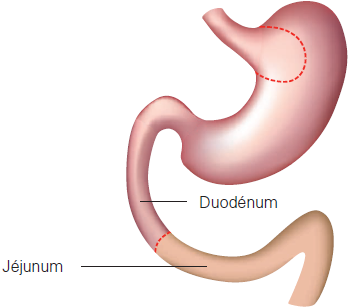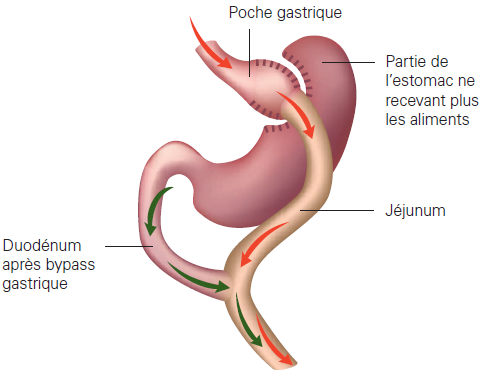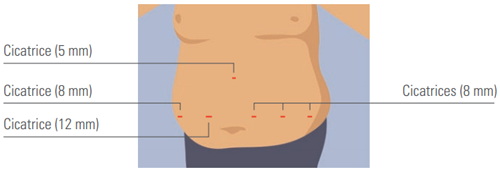- How does the procedure work ?
- How do I lose weight ?
- How is the intervention carried out ?
- What is the expected weight loss ?
- What is the duration of the intervention and the length of hospital stay ?
- What are the possible complications ?
How does the procedure work ?
The gastric bypass technique is based on two principles: reducing the size of the stomach and reducing the absorption of food by bypassing a part of the small bowel.
How do I lose weight ?
Gastric restriction decreases the amount of food that you can eat, and satiety appears more quickly. Malabsorption leads to a reduction in the quantity of food assimilated by your body.
How is the intervention carried out ?
The surgery is performed under general anaesthesia, using a minimally invasive approach(i.e. keyhole surgery), usually with the surgical robot. Briefly, a camera is inserted through a small hole in the abdominal wall and instruments are inserted through five other small holes (see illustration of procedure ).
he stomach is divided using a surgical stapler, creating a small gastric pouch which can only accommodate 30 ml of food volume (approximately 1 oz).. The intestine is divided and connected to the gastric pouch, and a small bowel bypass is created.
At the end of the procedure, the incisions are closed with absorbable suture (which disappears on its own). Wound dressing is made with glue, which is also eliminated on its own.
What is the expected weight loss ?
The gastric bypass technique allows to lose about 65 to 75% of the excess weight. To give you an example, if your current weight is 130 kg and your ideal weight (i.e. the weight which will give you a BMI of 25) is 70 kg, your excess weight is 60 kg. You can expect to lose approximately two-thirds of these 60 kg, which means 40 kg.
Please be aware that these are only estimates, based on large number of patients who underwent gastric bypass surgery. Individual results might vary.


![]()

What is the duration of the intervention and the length of hospital stay ?
The surgery usually takes between 1 and half and 3 hours. Most patients stay three nights in the hospital.
What are the possible complications ?
Complications of obesity surgery are rare but can unfortunately occur.
In the days following the intervention
- A rupture of the internal sutures (intestine or stomach) occurs very rarely (less than 0.2% of cases) and is called an “anastomotic leak” or sometimes only a “leak”. Smoking and diabetes significantly increase the risk of a having a leak. Antibiotics, drainage or surgery might be required if a leak occurs.
- Other complications occur in approximately 1% of patients, and include: haemorrhage, intestinal obstruction, abscess, pulmonary embolism.
More than 30 days after the intervention
- Internal hernia, which sometimes causes intestinal obstruction, occurs in 3%-5% of patients and might require emergent surgery.
CAUTION
f you underwent bypass surgery and experience severe, sudden and continuous pain lasting for more than an hour, go to the emergency department. You could be suffering from an internal hernia.
- "Dumping syndrome" is manifested by great weakness and sweating after ingesting food. These symptoms are most often caused by hypoglycaemia due to excess insulin secretion. Frequent healthy snacks and a diet low in sugar and high in proteins can prevent it.
- Ulcer or narrowing of the connection between the stomach and the intestine (the anastomosis)
- Vitamins and/or micronutrients deficiencies, which can be treated by adjusting the dose of vitamins/micronutrients supplementation.
